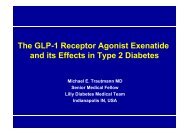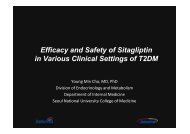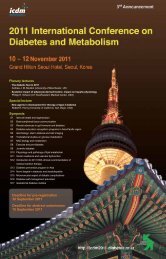The prevalence and clinical characteristics of diabetic neuropathy in ...
The prevalence and clinical characteristics of diabetic neuropathy in ...
The prevalence and clinical characteristics of diabetic neuropathy in ...
Create successful ePaper yourself
Turn your PDF publications into a flip-book with our unique Google optimized e-Paper software.
<strong>The</strong> <strong>prevalence</strong> <strong>and</strong> <strong>cl<strong>in</strong>ical</strong><strong>characteristics</strong> <strong>of</strong> <strong>diabetic</strong><strong>neuropathy</strong> <strong>in</strong> Korea: Results from a population-based study <strong>of</strong> type 2 <strong>diabetic</strong>patients <strong>in</strong> Korea by Korean Diabetes Association DiabeticNeuropathy Study GroupJong Chul Won, MD, PhDDepartment <strong>of</strong> Internal Medic<strong>in</strong>e, Cardiovascular <strong>and</strong>Metabolic Disease Center, Inje University,Sanggye Paik Hospital, Inje University School<strong>of</strong> Medic<strong>in</strong>e, Seoul
• In the West bare feetare a sign <strong>of</strong> humility<strong>and</strong> poverty. Christ <strong>and</strong>the Apostles,Franciscan friars, <strong>and</strong>sa<strong>in</strong>ts are all depicted <strong>in</strong>art without footwear.• Eastern nationscustomarily perform allacts <strong>of</strong> religious worshipwith bare feet.• In antiquity bare feetwere also sign <strong>of</strong>mourn<strong>in</strong>g.
•Diabetes was associated with 2-3 folds<strong>in</strong>creased risk <strong>of</strong> be<strong>in</strong>g unable to domobility-related task 1,2• <strong>The</strong> severity <strong>of</strong> <strong>diabetic</strong> peripheral<strong>neuropathy</strong> (DPN) was predictive <strong>of</strong> thedecreased QoL 31. Gregg EW, Diabetes Care, 2000• DPN <strong>and</strong> its Cx are reported to2. Volpato S, Diabetes Care, 2002account for nearly 27% <strong>of</strong> direct medical3. Currie CJ, Diabetologia, 2006costs <strong>of</strong> diabetes 4 4. Daousi C, Diabet Med, 2004
Foot disease <strong>in</strong> patients with diabetesFoot amputation rate (2003) Foot ulcer rate (2003)50.040.047.8100.080.091.030.060.020.040.010.04.720.011.70.0non-<strong>diabetic</strong><strong>diabetic</strong>0.0non-<strong>diabetic</strong><strong>diabetic</strong>Per population <strong>of</strong> 100,000Analysis <strong>of</strong> the medical records sampled from the health <strong>in</strong>surance data regard<strong>in</strong>g claims with footamputation (Z894-899), ulcer <strong>of</strong> lower limb (L97), gangrene (R02), <strong>in</strong>sul<strong>in</strong>-dependent diabetes (E10), non<strong>in</strong>sul<strong>in</strong>dependent diabetes (E11), malnutrition related diabetes (E12), other specified diabetes (E13) orunspecified diabetes (E14) as pr<strong>in</strong>cipal or secondary diagnosis between Dec 1994 <strong>and</strong> Dec 2002.KDA Diabetes <strong>in</strong> Korea, 2007
Total medical cost <strong>in</strong> patients with<strong>diabetic</strong> foot diseaseFoot amputation (2003) Foot ulcer (2003)Mean annual total medical costper person (1,000 KRW)14,00012,00010,0008,0006,0004,0002,0000579DM (-)outpatient6,097DM (-)hospitalization1,309DM (+)outpatient11,931DM (+)hospitalization10,0008,0006,0004,0002,0000550DM (-)outpatient4,538DM (-)hospitalization1,757DM (+)outpatient7,907DM (+)hospitalizationKDA Diabetes <strong>in</strong> Korea, 2007
12Prevalence <strong>and</strong> Cl<strong>in</strong>ical Characteristics<strong>of</strong> DPN <strong>in</strong> KoreaCl<strong>in</strong>ical Implications <strong>of</strong> DPN <strong>in</strong> Korea
DISCLOSUREAnalysis <strong>of</strong> data from the results <strong>of</strong> “Study for evaluation <strong>of</strong> pa<strong>in</strong><strong>and</strong> QOL <strong>in</strong> patients with DPN <strong>in</strong> Korea”, which enrolled 4,000<strong>diabetic</strong> patients from 40 hospitals throughout Korea dur<strong>in</strong>g 2009~ 2010.– [당뇨병성 신솟경병증환자에숷서의 통증의 정도 및 삶의 질에숷 관한 연구]– Sponsored by Pfizer Korea <strong>in</strong>c.Announcement <strong>of</strong> results– F<strong>in</strong>al meet<strong>in</strong>g <strong>of</strong> research group, 10-Sept, 2010– Prelim<strong>in</strong>ary results were presented <strong>and</strong> discussed at 8 th IDFmeet<strong>in</strong>g at Busan <strong>in</strong> 2010 (by Dr. JH Kim).
Prevalence <strong>and</strong> Cl<strong>in</strong>icalCharacteristics <strong>of</strong> DPN <strong>in</strong> Korea
Prevalence <strong>of</strong> <strong>diabetic</strong> <strong>neuropathy</strong> <strong>in</strong> patients withdiabetes from cross-sectional research studies <strong>in</strong>Korea (1957~1994)Study site <strong>and</strong> year Neuropathy diagnosis Subjects, n Prevalence, %Seoul, 1957~1977 NA 5,601 32.7Seoul, 1963 ~ 1973 NA 1,332 22.9Nationwide, 1976 NA 3,076 28.9Kwangju, 1976 ~ 1981 NA 779 14.1Seoul, 1981~1983 Symptoms, signs, NCV 300 54.5Seoul, 1982 Symptoms, signs, NCV 224 45.5Seoul, 1990 Symptoms, signs, NCV 837 48.9Seoul, 1993 Symptoms, signs, NCV 1,301 39.0Seoul, 1994 Symptoms, signs, NCV 668 19.0Seoul, 1994 Symptoms, signs, NCV 235 37.5Taegu, 1999 Symptoms, signs, NCV 1,270 47.6NA, not available; NCV, nerve conduction velocityKim SY, J Korean Diabetes Assoc 1979; Han DH, J Korean Diabetes Assoc 1974; Son SK, J KoreanDiabetes Assoc 1976; Lee TH, J Korean Diabetes Assoc 1981; Lee HC, J Korean Diabetes Assoc1984; Lee MK, J Korean Diabetes Assoc 1983; Hong YS, J Korean Diabetes Assoc 1990; Kim SM, JKorean Diabetes Assoc 1993; Park JY, J Korean Diabetes Assoc 1993
Study for evaluation <strong>of</strong> pa<strong>in</strong> <strong>and</strong> QOL <strong>in</strong>patients with DPN <strong>in</strong> KoreaObjectives– Evaluation <strong>of</strong> impact <strong>of</strong> DPN on the disease burden <strong>and</strong> QOL<strong>of</strong> <strong>diabetic</strong> patientsMethods– For nationwide survey, we <strong>in</strong>vestigated 4,000 patientsthroughout 40 hospitals by questionnaires, <strong>cl<strong>in</strong>ical</strong>exam<strong>in</strong>ation <strong>and</strong> review <strong>of</strong> medical records.– Measures <strong>of</strong> patients-reported outcomes: Brief Pa<strong>in</strong> Inventory(BPI)-Short Form (SF), Medical Outcomes Study (MOS) –Sleep, EuroQOL-5 dimensions (EQ-5D).– Diagnosis <strong>of</strong> DPN: Known DPN (typical symptoms, sensorymotornerve test <strong>in</strong>clud<strong>in</strong>g neurologic or electrophysiologicalexam<strong>in</strong>ation) or MNSI (2>) <strong>and</strong> positive 10-g mon<strong>of</strong>ilamenttest.MNSI, Michigan Neuropathy Screen<strong>in</strong>g Instrument.
Prevalence <strong>of</strong> DPNN = 3,339Non-DPNDPN33.5%66.5%Firstly diagnosed DPNDPN:Previously diagnosed by symptomDPN:Previously diagnosed by signDPN:Previously diagnosed by symptom <strong>and</strong> sign6.3%4.8%27.2%8.3%14.1%
Cl<strong>in</strong>ical <strong>characteristics</strong> <strong>of</strong> DPN <strong>in</strong> Korea (1)(n, %) DPN (1,338, 33.5) Non-DPN (2,661, 66.5)Age (yr) 62.7 ± 10.7* 59.4 ± 11.3Women (n,%) 745 (55.7)* 1315 (49.4)Duration <strong>of</strong> diabetes (yrs) 11.8 ± 8.0* 8.4 ± 7.1Current smoker (%) 16.7 17.4Diabetes treatment (%)Diet <strong>and</strong> exerciseOHAInsul<strong>in</strong>Comb<strong>in</strong>ation <strong>of</strong> OHAs <strong>and</strong> <strong>in</strong>sul<strong>in</strong>9.6*52.5*12.9*25.0*15.065.66.912.4BMI (kg/m 2 ) 25.4 ± 3.1 23.6 ± 3.1Data are mean ± SD. * P < 0.05 vs Non-DPN. OHA, oral hypoglycemic agent; BMI, body mass <strong>in</strong>dex.
Cl<strong>in</strong>ical <strong>characteristics</strong> <strong>of</strong> DPN <strong>in</strong> Korea (2)(n, %) DPN (1,338, 33.5) Non-DPN (2,661, 66.5)Systolic BP (mm Hg) 127.5 ± 15.5 127.0 ± 14.4Diastolic BP (mm Hg) 74.5 ± 10.3 75.3 ± 9.8Fast<strong>in</strong>g plasma glucose (mmol/L) 7.9 ± 3.1 7.9 ± 2.7A1C (%) 7.8 ± 2.4 7.6 ± 2.9Total cholesterol (mmol/L) 4.4 ± 1.1 4.4 ± 1.1Triglyceride (mmol/L) 1.6 ± 1.0 1.7 ± 1.2HDL-cholesterol (mmol/L) 1.2 ± 0.4 1.2 ± 0.3LDL-cholesterol (mmol/L) 2.4 ± 0.9* 2.6 ± 0.9Data are mean ± SD. * P < 0.05 vs Non-DPN. BP, blood pressure; A1C, hemoglob<strong>in</strong> A1 C ; HDL, high density lipoprote<strong>in</strong>;LDL, low density lipoprote<strong>in</strong>.
Cl<strong>in</strong>ical <strong>characteristics</strong> <strong>of</strong> DPN <strong>in</strong> Korea (3)(n, %) DPN (1,338, 33.5) Non-DPN (2,661, 66.5)Hypertension (%) 65.7* 50.8Dyslipidemia (%) 52.6* 46.9Any ret<strong>in</strong>opathy (%) 31.8* 15.6Nephropathy (%) 22.5* 12.3History <strong>of</strong> CVDs (%) 12.0* 6.8History <strong>of</strong> CVAs (%) 6.4* 4.0History <strong>of</strong> PADs (%) 7.3* 1.5Foot ulcer or amputation (%) 3.1* 0.3MNSI scores 3.1 ± 2.2* 1.5 ± 1.5Abnormal site <strong>of</strong> mon<strong>of</strong>ilament test (n)Rt. FootLt. foot1.8 ± 2.6*1.8 ± 2.6*0.3 ± 1.00.3 ± 1.0Data are mean ± SD. * P < 0.05 vs non-DPN.; CVD, cardiovascular disease; CVA, cerebrovascular accident; PAD,peripheral arterial disease; MNSI, Michigan Neuropathy Screen<strong>in</strong>g Instrument.
Prevalence <strong>of</strong> DPN accord<strong>in</strong>g to theduration <strong>of</strong> diabetes (yrs)DPNNon-DPN100.00%80.00%60.00%78.5%68.5%54.7%40.00%20.00%21.5%31.5%45.3%0.00%< 5 5 -1 0 ≥ 10
Prevalence <strong>of</strong> DPN stratified by age (yrs)(A) <strong>and</strong> glycemic status (A1C, %) (B)A.60.0%50.0%40.0%30.0%20.0%10.0%0.0%P for trend < 0.05< 50 (n = 650) 50 ~ 59 (n = 1,193) 60 ~ 69 (n = 1,314) ≥ 70 (n = 842)B.40.0%30.0%P for trend < 0.0520.0%10.0%0.0%< 7.0 (n = 1,576) 7.0 ~ 9.0 (n = 1,813) ≥ 9.0 (n = 610)
Temporal <strong>prevalence</strong> (%) <strong>of</strong> <strong>diabetic</strong> complicationsaccord<strong>in</strong>g to quartile <strong>of</strong> duration <strong>of</strong> diabetes (yrs)60.050.0Neuropathy Ret<strong>in</strong>opathy Nephropathy Any macroangiopathyAll P for trend < 0.0540.030.020.010.00.0Q1 (< 3.6, n = 1,033) Q2 (3.7 ~ 7.7, n = 960) Q3 (7.8 ~ 13.6, n = 969) Q4 (≥ 13.7, n = 1036)
ORs <strong>of</strong> risk factorsassociated with DPN (1)• With multivariate logisticregression analysis• Log-transformed ODs( 95% CI)A1C, hemoglob<strong>in</strong> A1C; CVD,cardiovascular disease; CVA,cerebrovascular accident; PAD, peripheralarterial disease; MNSI, MichiganNeuropathy Screen<strong>in</strong>g Instrument.
ORs <strong>of</strong> risk factors associated with DPN (2)Variables OR (95% CI) P valueAge (yr) 1.014 (1.004, 1.024) 0.0038Diabetes duration (≥ 10 yrs vs 5 yrs) 1.449(1.126, 1.864) 0.0039Ret<strong>in</strong>opathy 1.826(1.454, 2.292)
Comparison <strong>of</strong> MNSI score between <strong>in</strong>patients with DPN <strong>and</strong> Non-DPNMNSI 설문 문항 DPN Non-DPN1. 발 또는 다리에숷 저린 감이 있습솚니까? 868(64.87) 954(35.85)2. 발 또는 다리에숷 화끈거리는 통증을 느낀 적이 있습솚니까? 454(33.93) 392(14.73)3. 발에숷 무엇이 닿을 때 과민하게 느낍니까? 252(18.83) 198(7.44)4. 발 또는 다리에숷 갑자기 쥐가 납니까? 617(46.11) 890(33.45)5. 발 또는 다리에숷 찌르는 듯한 느낌을 받은 적이 있습솚니까? 547(40.88) 469(17.62)6. 이불이 피부에숷 닿을 때 아쇾픔을 느낍니까? 82(6.13) 58(2.18)7. 목욕할 때 뜨거운 물과 차가운 물을 구분할 수 있습솚니까? 51(3.81) 42(1.58)8. 발에숷 까진 상처가 생긴 적이 있습솚니까? 162(12.11) 144(5.41)9. 의사로부터 '당뇨병성 신솟경병증' 이라고 진단된 적이 있습솚니까? 171(12.78) 31(1.16)10. 다리나 발에숷 마비가 있습솚니까? 221(16.52) 142(5.34)11. 다리나 발의 증상이 밤에숷 더 심솣해집니까? 478(35.72) 392(14.73)12. 걸을 때 다리가 아쇾픕니까? 493(36.85) 461(17.32)13. 걸을 때 발에숷 감각을 느낄 수 있습솚니까? 104(7.77) 109(4.10)14. 발의 피부가 건조해서 자주 갈라집니까? 490(36.62) 731(27.47)15. 발이나 발가락을 자르는 수술셶을 받은 적이 있습솚니까? 39(2.91) 9(0.34)Mean score ± SD 3.13±2.19 1.50±1.54N (%). All P < 0.05 between DPN <strong>and</strong> Non-DPN. DPN, <strong>diabetic</strong> peripheral <strong>neuropathy</strong>; MNSI, Michigan NeuropathyScreen<strong>in</strong>g Instrument. A “no” response on items 7 <strong>and</strong> 13 counts as 1 po<strong>in</strong>t. Item #4 is a measure <strong>of</strong> impairedcirculation <strong>and</strong> item #10 is a measure <strong>of</strong> general aesthenia <strong>and</strong> are not <strong>in</strong>cluded <strong>in</strong> scor<strong>in</strong>g.
Comparison <strong>of</strong> MNSI symptom distributionbetween 2005 <strong>and</strong> 2010 surveyResponder (%)1. 발 또는 다리에숷 저린 감이 있습솚니까?2. 발 또는 다리에숷 화끈거리는 통증을 느낀 적이 있습솚니까?3. 발에숷 무엇이 닿을 때 과민하게 느낍니까?4. 발 또는 다리에숷 갑자기 쥐가 납니까?5. 발 또는 다리에숷 찌르는 듯한 느낌을 받은 적이 있습솚니까?6. 이불이 피부에숷 닿을 때 아쇾픔을 느낍니까?7. 목욕할 때 뜨거운 물과 차가운 물을 구분할 수 있습솚니까?8. 발에숷 까진 상처가 생긴 적이 있습솚니까?9. 의사로부터 '당뇨병성 신솟경병증' 이라고 진단된 적이 있습솚니까?10. 다리나 발에숷 마비가 있습솚니까?11. 다리나 발의 증상이 밤에숷 더 심솣해집니까?12. 걸을 때 다리가 아쇾픕니까?13. 걸을 때 발에숷 감각을 느낄 수 있습솚니까?14. 발의 피부가 건조해서 자주 갈라집니까?15. 발이나 발가락을 자르는 수술셶을 받은 적이 있습솚니까?2005, n = 472 2010, n = 13380 20 40 600 20 40 60A “no” response on items 7 <strong>and</strong> 13 counts as 1 po<strong>in</strong>t. Item #4 is a measure <strong>of</strong> impaired circulation <strong>and</strong> item #10 is a measure<strong>of</strong> general aesthenia <strong>and</strong> are not <strong>in</strong>cluded <strong>in</strong> scor<strong>in</strong>g. MNSI, Michigan Neuropathy Screen<strong>in</strong>g Instrument
Distribution <strong>of</strong> MNSI <strong>cl<strong>in</strong>ical</strong> scoreDPN (n = 1,338) Non-DPN (n = 2661)100.0%80.0%60.0%40.0%20.0%0.0%≤ 2.0 ≥ 3, < 5 ≥ 5, < 7 ≥ 7At each level, all P < 0.05 between DPN <strong>and</strong> Non-DPN. Scores with 0.5 <strong>in</strong>crements were rounded up to the next <strong>in</strong>teger.DPN, <strong>diabetic</strong> peripheral <strong>neuropathy</strong>; MNSI, Michigan Neuropathy Score Instrument.
DPN: treatmentTreatment (+) Treatment (-)30.2%69.8%local preparationSSRIopiodiSSNRITCAsgamma-l<strong>in</strong>oleic acidanti-convulsant drugalpha-lipoic acid0.0% 20.0% 40.0% 60.0%20.1% patients receivedmore than one medication.DPN patients with treatmenthad longer duration <strong>of</strong>diabetes, more <strong>in</strong>sul<strong>in</strong> use,<strong>and</strong> more ret<strong>in</strong>opathy,nephropathy <strong>and</strong>hypertension.However, mean number <strong>of</strong>site unable to feel themon<strong>of</strong>ilament was higher <strong>in</strong>DPN patients withouttreatment than those withtreatment (P < 0.001).
Cl<strong>in</strong>ical Implications <strong>of</strong> DPN <strong>in</strong>Korea
BPI-SF (1): Pa<strong>in</strong> severityNon-DPNDPNPa<strong>in</strong> severity <strong>in</strong>dexCurrent pa<strong>in</strong>Worst pa<strong>in</strong>Average pa<strong>in</strong>0.0 0.5 1.0 1.5 2.0 2.5 3.0 3.5All measures are P < 0.05 between DPN <strong>and</strong> Non-DPN. 0 (no pa<strong>in</strong>) to 10 (worst possible pa<strong>in</strong>) numericrat<strong>in</strong>g scales. Korean January 19, 2006, <strong>The</strong> University <strong>of</strong> Texas MD Anderson cancer center, Charles S.Cleel<strong>and</strong>, PhD.
BPI-SF (2): Pa<strong>in</strong> <strong>in</strong>terferenceNon-DPNDPNPa<strong>in</strong> <strong>in</strong>terference <strong>in</strong>dexEnjoyment <strong>of</strong> lifeSleepRelationshipNormal WorkWalk<strong>in</strong>gMoodGeneral activity0.0 0.5 1.0 1.5 2.0 2.5 3.0 3.5All measures are P < 0.05 between DPN <strong>and</strong> Non-DPN. 0 (no pa<strong>in</strong>) to 10 (worst possible pa<strong>in</strong>) numericrat<strong>in</strong>g scales.
MOS-sleep scale• 당신솟이 필요한 만큼 충분히 많이 잠을 잤습솚니까?• 낮에숷 완전히 잠이 깬 상태로 있기 어숦려웠습솚니까?• 잠 자는 동안숀 깨고 다시 잠들기 어숦려웠습솚니까?• 잠들기가 어숦려웠습솚니까?• 숨셷이 차서 또는 머리가 아쇾파 잠을 깨숲습솚니까?• 아쇾침에숷 일어숦났을 때 잘 쉬솆숲다고 느낄 만큼 충분한 수면을취했습솚니까?Quantity <strong>of</strong> sleep/OptimalsleepSomnolenceSleep ma<strong>in</strong>tenanceSleep disturbanceAwaken short <strong>of</strong> breath orheadacheSleep adequacyHays, RD, <strong>The</strong> Medical Outcomes Study approach, Duke University Press, 1992
MOS-sleep scaleNon-DPNDPNQuality <strong>of</strong> sleep/Optimal sleepSomnolenceSleep ma<strong>in</strong>tenance Snor<strong>in</strong>gSleep disturbanceAwaken short <strong>of</strong> breath or headacheSleep adequacy0 10 20 30 40 50 60 70 80 90 100All measures are P < 0.05 between DPN <strong>and</strong> Non-DPN. Numeric rat<strong>in</strong>g score (1, always; 6, never)transformed to 0 ~ 100.Hays, RD, <strong>The</strong> Medical Outcomes Study approach, Duke University Press, 1992
EQ-5D descriptive system: 5 dimensionsNon-DPNDPNAnxiety/DepressionPa<strong>in</strong>/DiscomfortUsual activitySelf-careMobility0.0 10.0 20.0 30.0 40.0 50.0Percentages <strong>of</strong> respondents report<strong>in</strong>g more than “some problem”. Each question has three levels<strong>in</strong>dicat<strong>in</strong>g “no problem (or 1),” “some problems (or 2),” <strong>and</strong> “severe problems (or 3),” respectively. EQ-5D, EuroQoL-5 Dimensions.EuroQol Group, Health Policy, 1990All measures are P < 0.05 between DPN <strong>and</strong> Non-DPN
EQ-5D <strong>in</strong>dex: Korean Scor<strong>in</strong>gNon-DPNP < 0.05DPN0.0 0.2 0.4 0.6 0.8 1.0Korean version, © 1990 EuroQol Group. <strong>The</strong>se weights lie on a scale on which full health has avalue <strong>of</strong> 1 <strong>and</strong> dead a value <strong>of</strong> 0.EQ-5D, EuroQoL-5 Dimensions.Kang EJ, Value Health, 2009
Patients awareness <strong>of</strong> DPNAwarenessYes No12.6%87.4%27.2%Education27.8%Foot care72.8%72.2%
SummaryMore than one third <strong>of</strong> patients with type 2 diabetes were DPN.DPN patients had high <strong>prevalence</strong> <strong>of</strong> diabetes-relatedcomplications <strong>and</strong> co-morbidity.Risk factors associated with DPN were age, duration <strong>of</strong> diabetes,<strong>diabetic</strong> complications (ret<strong>in</strong>opathy, CVD, <strong>and</strong> PAD), <strong>and</strong> comorbidities(hypertension <strong>and</strong> dyslipidemia).High <strong>prevalence</strong> but low proper management <strong>and</strong> awareness <strong>of</strong>their own DPN deserves attention from cl<strong>in</strong>icians to ensure bettermanagement <strong>of</strong> diabetes <strong>in</strong> Korea.Further analysis: Cl<strong>in</strong>ical implications <strong>of</strong> pa<strong>in</strong>ful-DPN, QOL issue,<strong>and</strong> disease burden.
Investigators <strong>and</strong> study centers<strong>in</strong>cluded <strong>in</strong> this analysis:강남 세브란스솔병원강남성심솣병원강릉아쇾산병원강북삼성병원경상대병원계명대병원고대구로병원고대안숀암숇병원길병원노원을지병원대구가톨릭병원대전을지병원동서신솟의학병원부산대병원부산백병원부천세종병원분당서울대병원분당제생병원분당차병원삼성서울병원충북대병원안숀철우홍은경심솣명셳박철영함종렬김혜순셴최경묵김신솟곤박이병민경완이지현박강서정인경김인주박정현김종화임수김용현김수경이명솞오태근상계백병원상계백병원서울성모병원서울아쇾산병원성가병원순셴천향서울병원순셴천향부천병원순셴천향천안숀병원여의도성모병원영남대병원예수병원울산대부속셏병원원주기독병원의정부성모병원이대목동병원전북대병원중앙숋대병원 (용산)중앙숋대병원 (흑석동)춘천성심솣병원화순셴전남대병원고경수원종철차봉연이우제김성래변동원정찬희김상진권혁상원규장송셗선경김영일정춘희손셑태서오지영박태선안숀지현김재택류옥현강호철
AcknowledgementFully acknowledged the participat<strong>in</strong>g <strong>in</strong>vestigators <strong>and</strong> steer<strong>in</strong>g members <strong>of</strong>Korean Diabetic Neuropathy Study Group. Special thank to pr<strong>of</strong>essor Ki JunSong (Department <strong>of</strong> Health statistics, Yonsei University, School <strong>of</strong> Medic<strong>in</strong>e,Seoul, Korea) for statistical analysis.
Thank you for your attention!


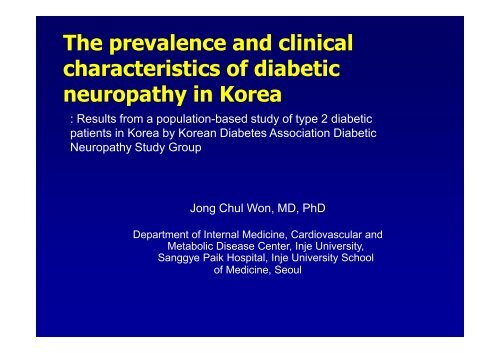
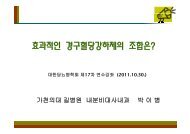
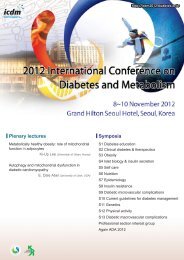
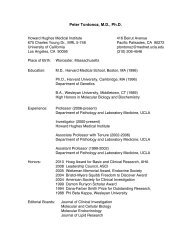
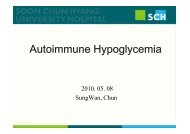
![Microsoft PowerPoint - src.ppt [\310\243\310\257 \270\360\265\345]](https://img.yumpu.com/47977670/1/190x134/microsoft-powerpoint-srcppt-310243310257-270360265345.jpg?quality=85)



![Microsoft PowerPoint - src.ppt [\310\243\310\257 \270\360\265\345]](https://img.yumpu.com/44373305/1/190x134/microsoft-powerpoint-srcppt-310243310257-270360265345.jpg?quality=85)
